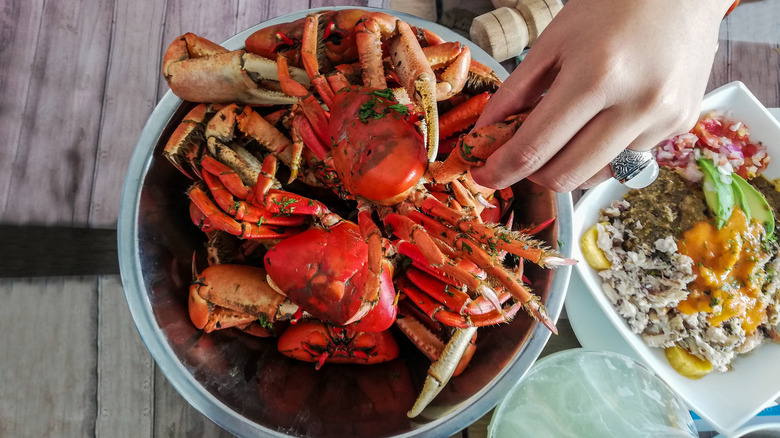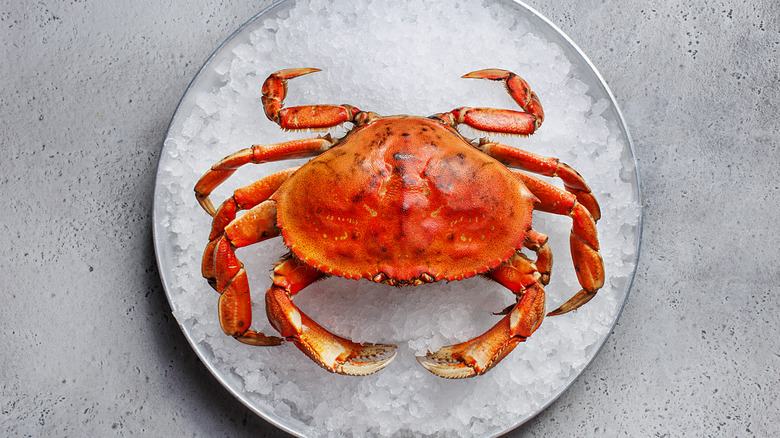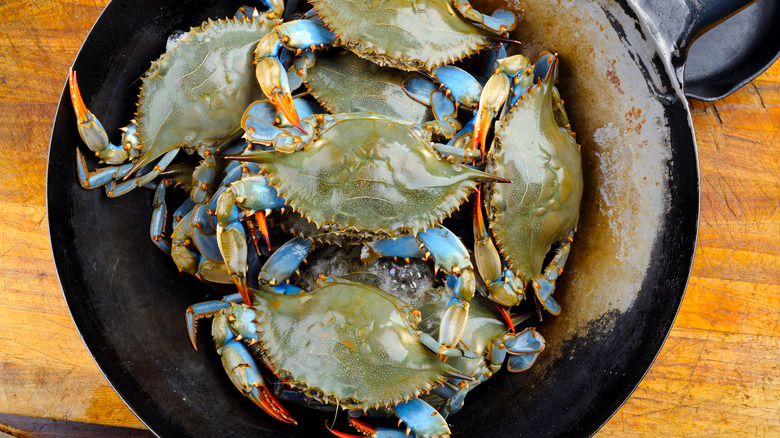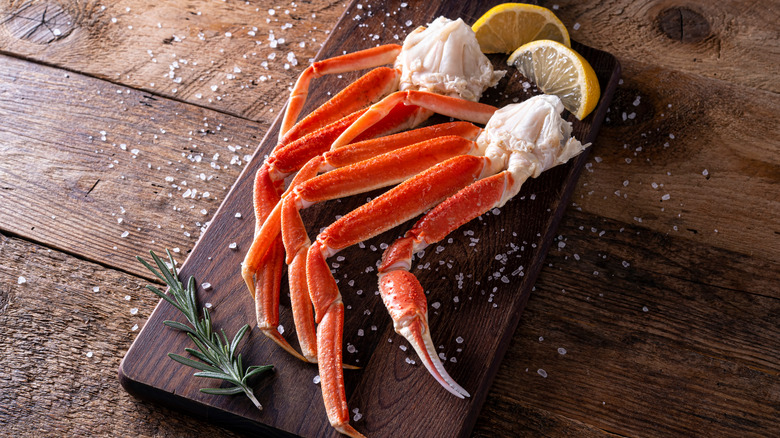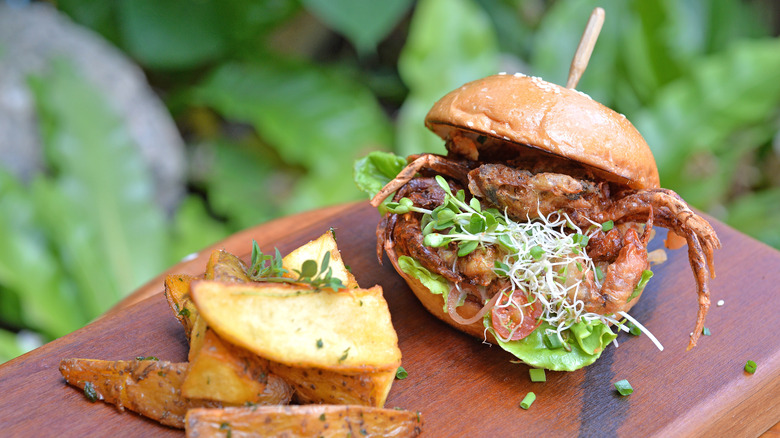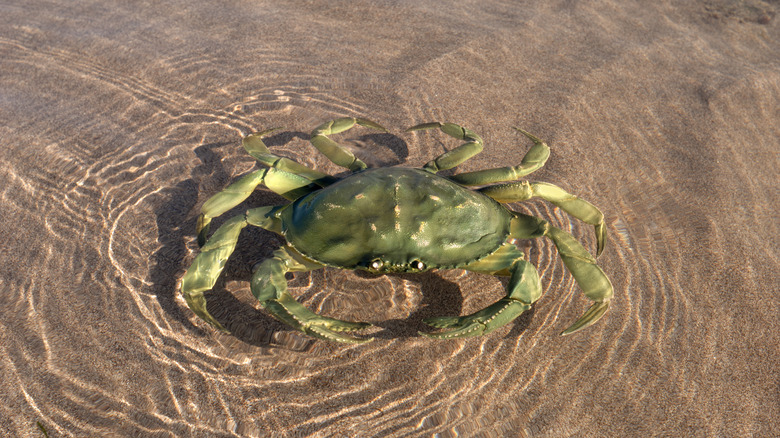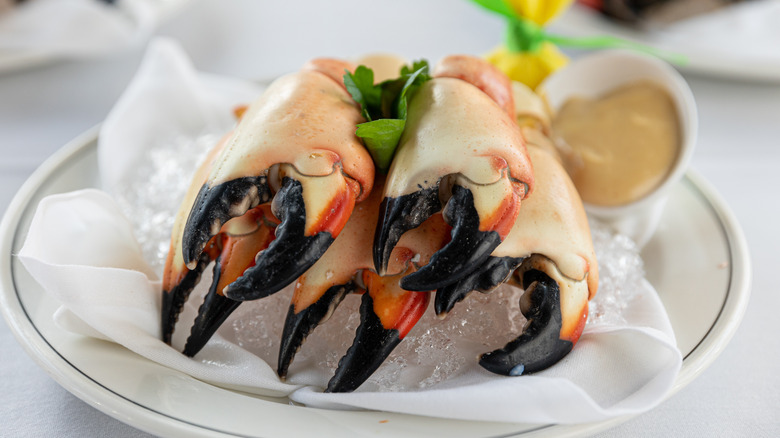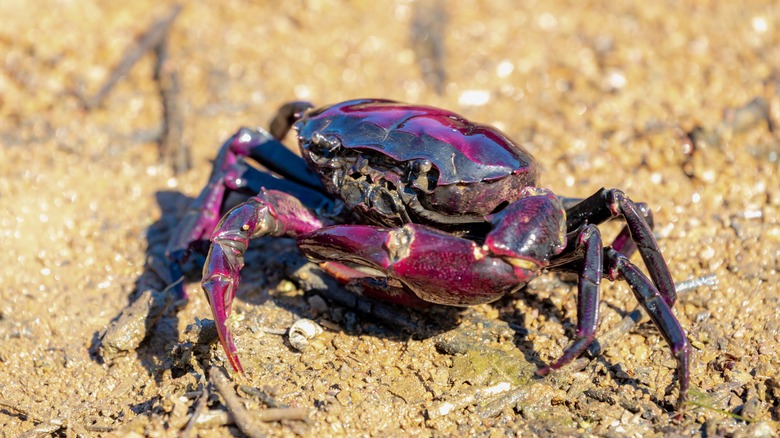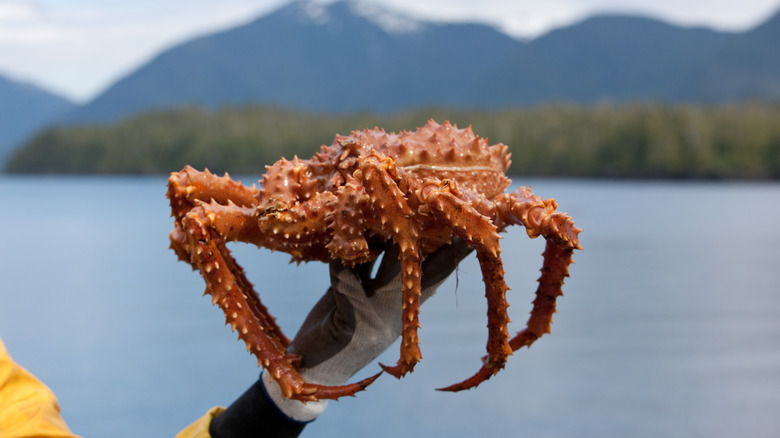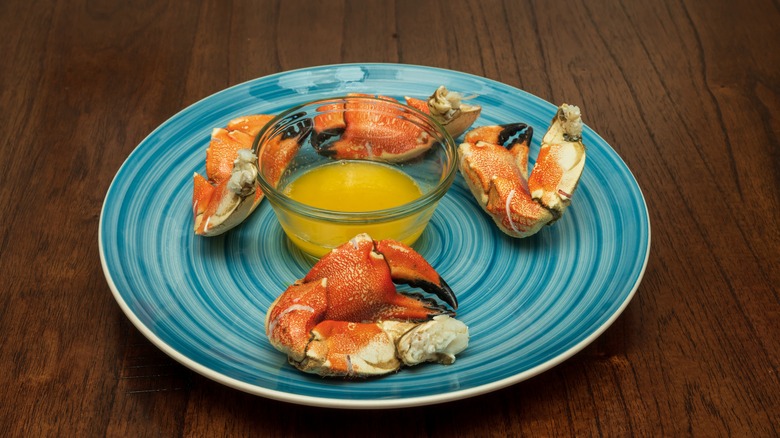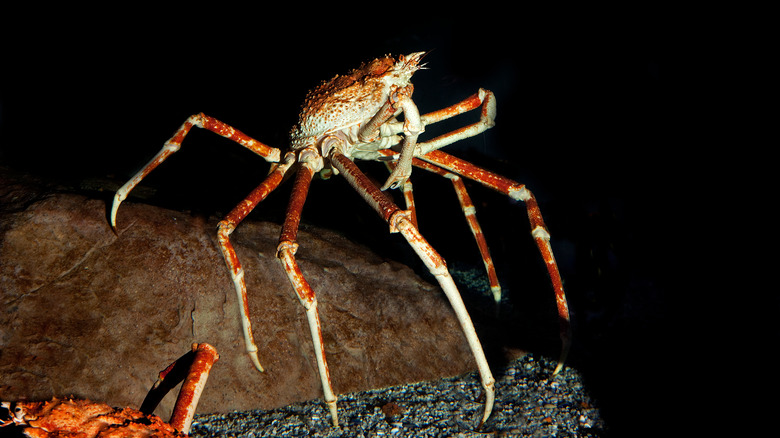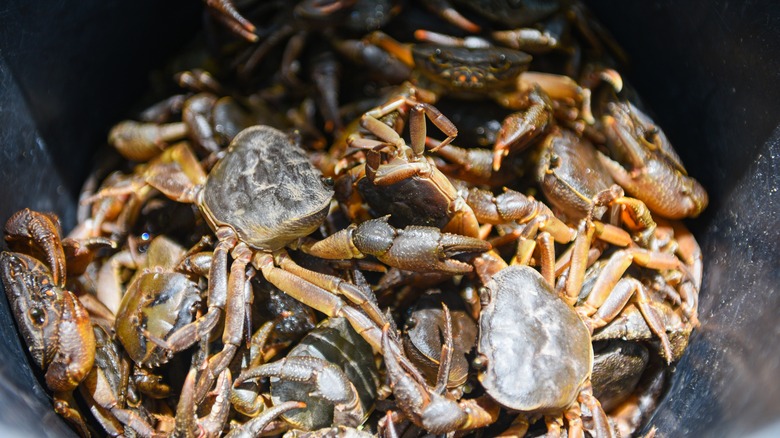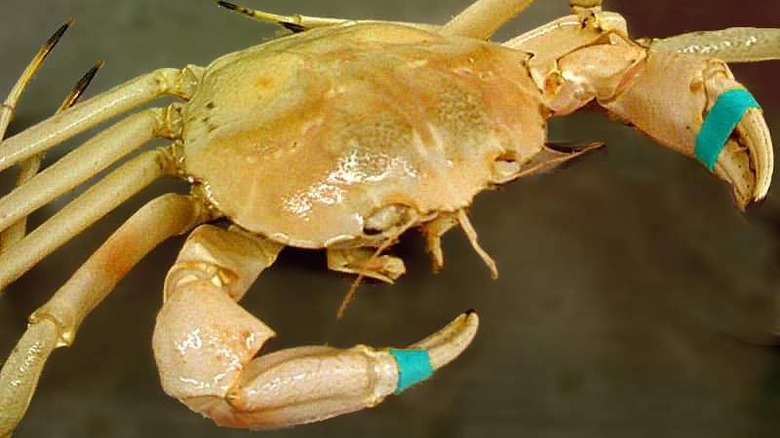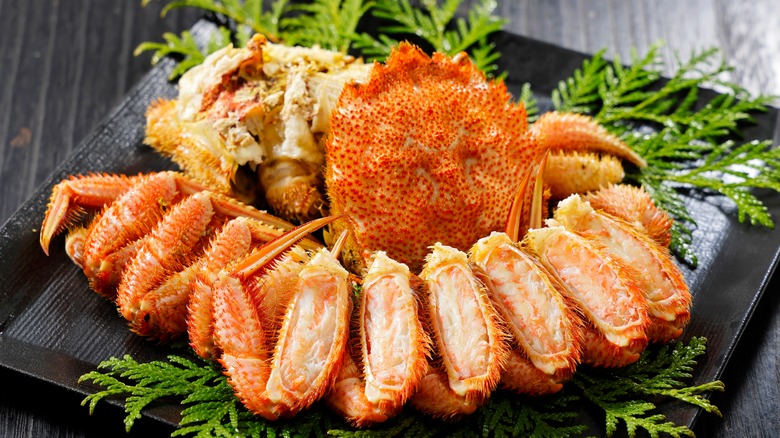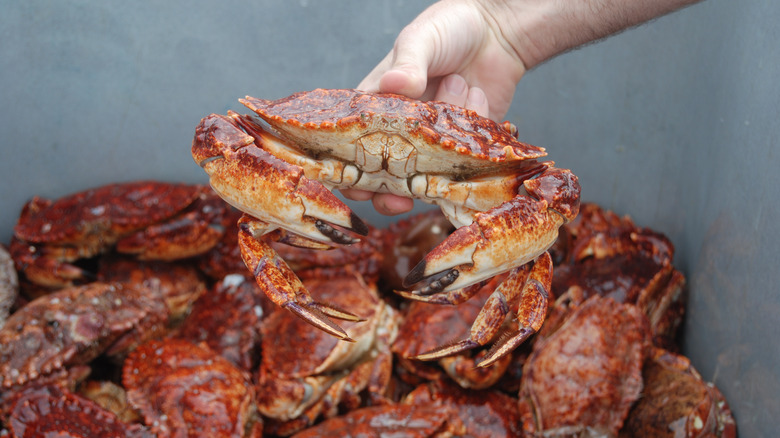14 Types Of Crab And How To Eat Them, According To Seafood Experts
With its sweet, enticing flavor and light, flaky meat, crab is one of the most delicious crustaceans out there and is considered a delicacy all over the world. From giant crabs found on the Alaskan coast and around Japan to tiny, colorful land crabs that live in the South Pacific, you'll find crab on the menu in almost every seaside region. As well as tasting great on its own, crab meat is highly versatile and can be incorporated into a variety of creative recipes. Spicy food lovers can cook up south Indian crab curries, like Jenji Gassi – one of the best Indian dishes you should try at least once – while seafood purists can enjoy juicy crab claws with just a squeeze of lemon and some crusty bread.
With so many edible crab species (including rare types of crabs) in the ocean and so many amazing crab preparations, we needed some extra help. So we spoke with several seafood experts who guided us through their favorite ways to prepare 13 different types of crabs.
1. Savor the sweet, nutty flavor of Dungeness crab
Dungeness crab is found on the West Coast and thrives in the cold waters around Northern California and right up to Alaska. Seafood lovers often venture to the San Francisco Bay area to eat Dungeness crab, as this region has a ton of great seafood restaurants. Bob Partrite is the former head chef and current chief operating officer for Simco Restaurants on San Francisco's Pier 39, including Crab House, Pier Market Seafood Restaurant, and Fog Harbor Fish House, which all serve Dungeness crab.
Partrite explains that Dungeness crab has a sweet, slightly nutty flavor that is easily overpowered by supporting ingredients. To avoid this, he advises chefs "to prepare [Dungeness crab] simply with fantastic ingredients that complement it and let the delicious taste shine though." Popular crab dishes at Simco Restaurants include a whole Dungeness crab cooked in garlic and fresh crab cakes with a smoky, harissa sauce.
A whole Dungeness crab can weigh between 2-3 pounds, making them an ideal size for 2-3 diners. To eat Dungeness crab, Partrite suggests that diners start by snapping off the legs and working out the meat before starting on the body. To ensure you get all the meat, crack the body with a crab mallet then bend it slightly, making the inside easier to shred with a fork.
2. Enhance blue crabs with ginger
According to Kaitlin Leung, co-author of the family-owned food blog, The Woks of Life, blue crabs pair best with "ginger, scallions, and garlic." Leung explains that "ginger really brings out the clean flavor of the crab meat," and that you can make delicious blue crabs by flash-frying them with these ingredients. Blue crabs are native to the Atlantic and span the whole East Coast, from Nova Scotia to Uruguay. They are frequently caught and eaten in Chesapeake Bay, which borders Virginia and Maryland.
Blue crabs are quite small, weighing only around a ⅓ pound each, which means that you'll need several crabs for a single-person entree. Male blue crabs are generally slightly larger than female blue crabs but, Leung adds, it's important to know which kind you're buying as the female crabs sometimes carry roe. These eggs have a creamy texture and an intense crab flavor. Female blue crabs are also slightly sweeter and less salty than males.
3. Eat snow crab with an ice cold beer
Native to the icy waters of the northwest Atlantic and the north Pacific, snow crab is known for its dense, white, leg meat. Snow crabs are usually flash-frozen after being caught and then precooked. The crab meat, which is red when raw, turns white during cooking and gives the snow crab its name. Flashing-freezing the crab meat also helps to retain the flavor, which is often described as a fresh, juicy balance between sweetness and salinity.
Flash-freezing means that snow crabs are also super easy to prepare. You can simply defrost them and serve them cold with dipping sauces or reheat them. Master Executive Chef Richard Beckel, from the Woodholme Country Club, states that when it comes to re-heating snow crabs he "likes to keep it simple, serving them steamed with cocktail sauce or aioli, paired with tomatoes and salads."
Chef Beckel adds that snow crab is particularly good served with beer — like choosing the best wines to pair with oysters, you'll want to find a slightly sharp or bitter beer that balances the crab's sweetness and cuts the brine. This pairing makes chilled snow crab legs a perfect dish to serve at a summer garden party.
4. Enjoy the crunch on soft-shell crab
The term soft-shell crab doesn't refer to a specific type of crab but, instead, is a crab preparation that allows you to cook and eat the whole crustacean. If you order soft-shell crab in a restaurant or buy them live or frozen, you will most likely be eating blue crabs. Soft-shell describes a crab that has recently molted or shed its carapace so that it can grow. Crabs are usually caught just before this process begins and then are stored live until they shed.
Molted crabs have a soft, rubbery outer skin which means they can be consumed whole once the insides have been removed — this will usually be done for you if the crabs are frozen. Defrosted or fresh soft-shell crabs can be cooked in a variety of ways, but frying is one of the more popular methods as it gives the crabs a nice crunch. Jecca Chantilly, a former chef and author of the food blog JeccaChantilly.com, explains that "soft-shell crabs have a mildly sweet and briny flavor [and are] often battered and deep fried to a crispy golden brown and served as a platter or in a sandwich." Similar to how to grill shrimp with the shell on, you can also toss soft-shell crab on the BBQ with some butter for around 10 minutes.
5. Make tasty soups and stews with green crabs
Mary Parks, executive director of Greencrab.org, explains that green crabs are "a culinary delicacy in their native range, eaten soft-shell, for their roe, and in stocks and stews." Parks notes that green crabs are common in Venetian cuisine, where both the roe and meat is consumed – one of the biggest mistakes you're making when ordering authentic Italian food is to sleep on the shellfish options. Parks adds that green crabs have a sweet, rich flavor that's perfect for adding depth to chowders, salads, or crab croquettes.
The green crab is typically found on European and North African coastlines but are also a notoriously successful invasive species that have overrun coastal environments all around the world. Once these small, colorful crabs move in, they pose a threat to the local marine ecosystem because they have limited predators and destroy regional shellfish populations, including those around New England, which have been severely affected.
6. Head to Florida to try the famous stone crabs
Stone crabs can be found throughout the southern Pacific and in the Gulf of Mexico but Chef Thomas Dritsas, corporate execute chef at Truluck's, notes that the Florida stone crab is the "ultimate crab experience." Florida stone crab claws have a strong, sweet flavor and a robust, meaty texture that makes them perfect for simple preparations that allow the crab flavor to hold its own. Dritsas states that he prefers to serve "stone crabs with precision cracking so the guest has easy access to the treasured meat from the interior and on ice with lemon and a traditional mustard sauce that is commonly served in Florida."
Stone crabs are also great to eat because they are a naturally sustainable food source. Dritsas explains that stone crabs are caught for their claws and then placed back in the ocean. Amazingly, the claws start to grow back after one year when the crab molts or sheds its skin. This means that live stocks are not depleted and helps protect marine biodiversity.
7. Snack on crispy purple shore crabs
Purple shore crabs are native to tropical climates and also live along the northern Pacific coast. These small, edible crabs can be found under rocks and in shallow water and are usually around 2 inches in size. According to Sheila Lucero, executive chef at Jax Fish House & Oyster Bar, the purple shore crabs' diminutive size is all part of the fun when it comes to cooking these tiny critters.
To make crispy purple shore crabs, Lucero recommends dusting the whole crab "in rice flour and frying them quickly. Toss them in ginger ponzu, lots of lime juice and sriracha. Kitchen snacks!" For the uninitiated, ponzu is a Japanese citrus and vinegar dipping sauce. The finished dish has a delightful crunch and a briny, umami flavor. You can also boil whole purple shore crabs to flavor soups and stews and eat the leg meat. As the crabs are so small, you will need a good bucketful to make a decently sized meal.
8. Fry giant king crabs with garlic
Primarily fished around the Alaskan coast in the Bering Sea, king crabs are the largest commercially fished crab species and can grow legs that are up to 5 feet long. These long, spindly giants yield a lot of meat, both in the legs and the bodies, and live deep below the ocean surface. While a lot of the king crab sold in the U.S. is flash-frozen and precooked, you can find live king crab served at some restaurants.
Kaitlin Leung notes that "a good Cantonese live seafood restaurant will [present] some of [the king crab] steamed in the shell with lots of minced garlic," while the rest is deep fried. Common Asian seasonings for king crab include scallions and soy sauce and it is also popular to serve some of the meat in the king crab shell mixed into fried rice. King crab is also a popular dish in Russian, European, and American cuisines.
If you're preparing frozen king crab at home, remember to go easy on the seasonings and ensure that frozen crab legs are completely defrosted but still chilled when served or cooked. This will help you avoid some of the most common mistakes everyone makes when cooking scallops and other shellfish.
9. Pair Jonah crabs with sushi and sake
If you want to try Jonah crab, the northwest coast around Maine and New England is the best place to visit. Jonah crabs live in cold water and are known for having exceptionally sweet meat. They are considered in season during the colder months, as this is when the meat is at its sweetest. Jonah crab is often sold frozen, as cocktail claws, or as a mix of the body and leg meat.
Richard Beckel lists Jonah crab as one of his favorites and notes that its "flaky, briny meat goes well with sushi because of its brininess." You can make maki rolls filled with dressed crab meat – selecting the freshest, highest-quality shellfish possible is one of the most important tips you need to know when making sushi at home – or top salmon nigiri with some shredded crab. Beckel also recommends pairing clean, citrusy flavors with Jonah crabs. Squeeze some lemon over your crab claws or sip on sake or a sharp Reisling to balance the meat's salty edge.
10. Make seafood pasta with spider crab meat
Spider crabs are routinely served up in European countries, like France, Italy, and Spain, and certain species can be found in the warm Mediterranean Sea and around the North African coast. Thomas Dritsas notes that you get a surprisingly small amount of meat from spider crabs, relative to their size.
Most of the meat on spider crabs comes from the top of the legs, where they join the body. These legs are extremely tough to crack — a useful method for eating them is to steam the crab and then break the leg joints to squeeze out the meat, rather than cutting through the claws. Dritsas notes that spider crabs "are good to steam in a large pot and eat with butter and lemon, or the extracted meat lends well to pasta." Spider crab pasta is a traditional Italian delicacy — it's usually cooked in a tomato, garlic, and white wine sauce — and is sometimes served inside the crab shell.
There is also an Atlantic spider crab that is fished in British and Irish waters and that is mainly exported to Europe, as well as a giant Japanese variety. Famous for their impressive leg span — the limbs can grow as long as 19 inches, while giant Japanese spider crabs can stretch up to an incredible 12 feet — and extremely hard shell.
11. Serve rock crabs with Béchamel sauce
When cooking rock crabs, Sheila Lucero recommends making an irresistible starter by "pulling all the meat and reserving the body shell to stuff with meat and bake with a delicious brandy-spiked bechamel sauce." Crab and dairy is a surprisingly popular combo, with dishes like crab au gratin and Basque baked crabs featuring a crab meat and bechamel mix. The potently sweet flavor of rock crab — which Lucero notes is similar to Dungeness crab — holds its own alongside a cheesy, creamy sauce, making for a decadently rich dish.
Red rock crabs are a West Coast species and are generally found in shoreline Pacific waters between Alaska and California, as well as in estuaries. You'll also find yellow rock crabs in coastal regions between California and Mexico. Rock crabs have a smooth carapace with large claws, which is where most of the meat comes from, and usually range in size from around 6-7.5 inches.
12. Use lemon and butter to enhance golden Atlantic crabs
Golden Atlantic crabs are an obscure delicacy that you'll usually only find readily available in Florida. These yellow crabs are fished from the cold, deep-sea waters of the South Atlantic and down into the Gulf of Mexico and are notoriously difficult to catch live because of the volatile currents in this region. According to Thomas Dritsas, Atlantic golden crabs yield delicate, sweet meat that "has similar taste qualities to the king crab."
Dritsas recommends a light touch when it comes to preparing Atlantic oglden crabs. The crabs can be "steamed or boiled and served up [with] lemon and butter" and some spices. If you're eating golden Atlantic crabs in Florida restaurants, you may also find the meat made into crab cakes or whole crabs cooked in garlic. These crabs can also be mixed in with other shellfish, like shrimp or lobster, for a seafood bisque or pasta.
13. Pair horsehair crabs with Japanese dashi
Found in the Pacific Ocean and the Sea of Okhotsk around northern Japan, horsehair crabs are a popular Japanese dish and eaten for both the meat and the roe. They are caught seasonally, available between March and May. Sheila Lucero raves about her experience eating horsehair crabs, explaining that she "had the opportunity to eat this crab in Japan. [It had] perfectly steamed meat pulled and dropped into a delicious dashi" — a broth made from kelp, shiitake mushrooms, and dry bonito fish flakes.
Horsehair crabs are small — usually just over 3 inches across – and have tightly packed, firm meat with a strong, sweet flavor. In contrast, the roe has a briny, umami taste. Boiled horsehair crab is often served alongside sashimi in Japanese restaurants and can also be added to hotpots and miso soup.
If you buy precooked, frozen horsehair crab, you can simply thaw it in the fridge and consume it cold. To cook fresh horsehair crab at home, you can boil it in salt water and then grill it in butter to enhance the rich, complex flavors.
14. Peekytoe crabs make delicious sushi
Native to Maine, Peekytoes are sand crabs and are generally prized for their sweet leg meat. Joel Hammond, chef de cuisine at Uchi Japanese Restaurant in West Hollywood, notes that peekytoe crabs have a flavor that is like "a mix between Dungeness and blue crab. [They are] great to boil to use the meat for sushi rolls or even just with lemon and butter."
He adds that peekytoes have a very hard shell which, combined with their small size — and the fact that the meat has to be handpicked — makes them quite labor-intensive to harvest. The name also comes from the crab's native territory, with the term peekytoe originating from a regional slang phrase for "picked toe." They are also sometimes referred to as Atlantic rock crabs. While they're not rare types of crabs, peekytoes may be hard to find outside of Maine or off the east coast.
Peekytoe crab meat is usually sold precooked — so you don't want to overdo it when it comes to reheating. This is why dishes like sushi work well, as the pre-boiled crab can be served chilled. If you do plan to reheat your shellfish, recipes where the meat is fried quickly, like crab spaghetti with chili and lime or crab cakes, are good choices to retain the delicate flavor.
